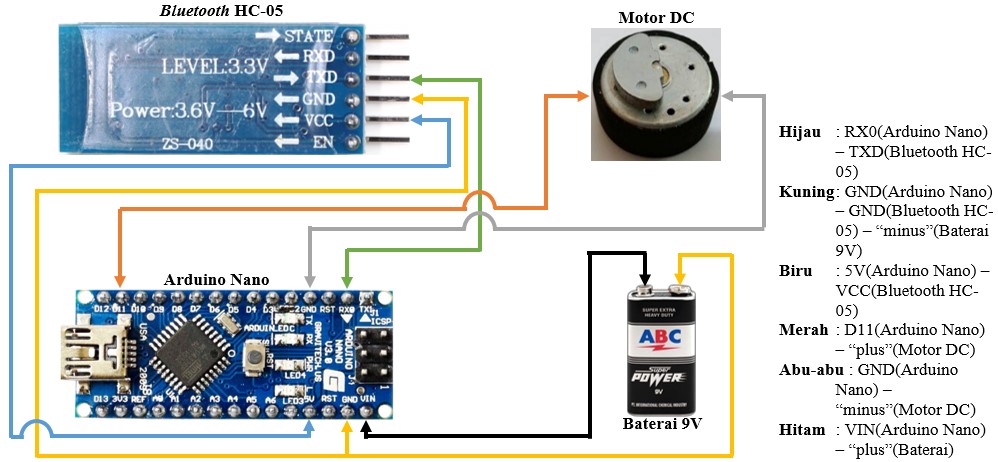Lafadz Takbir's Translator as a Deaf-Based Deaf Aid
DOI:
https://doi.org/10.12928/biste.v2i2.1607Keywords:
Speech Recognition, Tuna Rungu, Android, ArduinoAbstract
Speech recognition is a technique that allows a computer system to receive input in the form of a spoken word. The words are transformed into digital signals by changing sound waves into a group of numbers and then adjusted to certain codes and matched with a pattern stored in a device. The results of the identification of spoken words can be displayed in written form and can be read by technological devices. The tool in this study was designed to be able to help people with hearing impairment so they can participate in prayer in congregation in knowing the changing movements of prayer. This tool is designed with an Arduino Nano microcontroller board as a voice processing function received from speech recognition. The results issued by this tool in the form of vibrations that will be directly felt by the user. Presentation of success will increase if the sound around the input is not too noisy. Presentation of success in the words "Allahu Akbar" reached 82%, "Sami'allahu Liman Hamidah" reached 90%, and "Assalamualaikum Warahmatullahiwabarakatuh" reached 80%.
References
A. Yudhana and S. A. Akbar, “Sabuk Getar Sebagai Alat Bantu Penunjuk Arah Bagi Tunanetra,” Jurnal SINERGI, vol 18, no 2, pp.71-76, 2014.
A. Yudhana and M. Ramadhani, “Otomatisasi dan Instrumentasi untuk Proyek Smart Farming dan Smart Glove,” Yogyakarta: CV Mine. 2018.
S. Rosad, A. Yudhana, and A. Fadlil, “Jadwal Sholat Digital Menggunakan Metode Ephemeris Berdasarkan Titik Koordinat Smartphone”, ITJRD, vol. 3, no. 2, pp. 30 - 43, Jan. 2019. DOI: 10.25299/itjrd.2019.vol3(2).2285
A. Yudhana, A. Fadlil and S. Rosad, “Metode Look-Up Table pada Tampilan Jadwal Waktu Sholat Digital,” Jurnal Techno, vol. 20, no. 1, Pp. 11-9, 2019. DOI: 10.30595/techno.v20i1.3541
N. Hidayah, S. A. Akbar, A. Yudhana, “Pendidikan Inklusi dan Anak Berkebutuhan Khusus,” Yogyakarta : Samudra Biru, 2019.
D. Rahmi, “Minat Penyandang Hambatan Pendengaran Terhadap Penggunaan Alat Bantu Dengar,” Juppekhu: Jurnal Penelitian Pendidikan Khusus, vol. 4, no. 3, pp. 39-48, 2015. DOI: 10.24036/jupe60620.64
H. Ibrahim, S. Basri, Z. Hamzah, “Faktor-Faktor yang Berhubungan dengan Keluhan Gangguan Pendengaran pada Tenaga Kerja Bagian Produksi PT. Japfa Comfeed Indonesia, Tbk. Unit Makassar Tahun 2014,” Al-Sihah: Public Health Science Journal, vol. 8, no. 2, pp. 121-129, 2014. DOI: 10.24252/as.v8i2.2659
H. Ratih H. and Rr. A. P. Rini, “Pengaruh Auditori Verbal Therapy Terhadap kemampuan Penguasaan Kosa Kata Pada Anak Yang Mengalami Gangguan Pendengaran,” Pesona: Jurnal Psikologi Indonesia, vol. 4, no. 1, pp. 77-86 2015. DOI: 10.30996/persona.v4i1.493
Khairunizam, Danuri and Jaroji “Aplikasi Pemutar Musik Menggunakan Speech Recognition,” Jurnal Inovtek Polbeng – Seri Informatika, vol. 2, no. 2, 2017. DOI: 10.35314/isi.v2i2.196
N. F. I. Prayoga, Y. Astuti and C. B. Waluyo, “Analisis Speaker Recognition menggunakan Metode Dynamic Time Warping (DTW) Berbasis Matlab,” Jurnal AVITEC, vol 1, no 1. 2019. DOI: 10.28989/avitec.v1i1.492
N. R. Septiana and E. Widowati, “Gangguan Pendengaran Akibat Bising,” Higeia: Journal of Public Health Research and Development, vol. 1, no 1, pp. 73-82 2017.
N. H. Abdullah, M. T. Ananta and R. K. Dewi, “Pengembangan Pembantu Pemanggil Penyandang Tunarungu Menggunakan Library Pocketsphinx Berbasis Android (Studi Kasus PLSD Universitas Brawijaya),” Jurnal Pengembangan Teknologi Informasi dan Ilmu Komputer, vol. 2, no. 8, 2018.
Q. Nada, C. Ridhuandi, P. Santosa and D. Apriyanto “Speech Recognition dengan Hidden Markov Model untuk Pengenalan dan Pelafalan Huruf Hijaiyah,” Jurnal Al-Azhar Indonesia Seri Sains dan Teknologi, vol. 5, no. 1, 2019. DOI: 10.36722/sst.v5i1.319
Y. U. Solikhatun, “Penyesuaian Sosial Pada Penyandang Tunarungu di SLB Negeri Semarang,” Educational Psycology Journal, vol. 2, no. 1, pp. 65-72, 2013.
W. Liga, E. Fernando, and Hendri, “Perancangan Aplikasi Komunikasi Penyandang Tunarungu Berbasis Android,” Jurnal Processor, vol. 12, no. 1, 2017.

Downloads
Published
How to Cite
Issue
Section
License
Copyright (c) 2020 Denny Yoga Pratama, Anton Yudhana

This work is licensed under a Creative Commons Attribution-ShareAlike 4.0 International License.
Authors who publish with this journal agree to the following terms:
- Authors retain copyright and grant the journal right of first publication with the work simultaneously licensed under a Creative Commons Attribution License that allows others to share the work with an acknowledgment of the work's authorship and initial publication in this journal.
- Authors are able to enter into separate, additional contractual arrangements for the non-exclusive distribution of the journal's published version of the work (e.g., post it to an institutional repository or publish it in a book), with an acknowledgment of its initial publication in this journal.
- Authors are permitted and encouraged to post their work online (e.g., in institutional repositories or on their website) prior to and during the submission process, as it can lead to productive exchanges, as well as earlier and greater citation of published work (See The Effect of Open Access).
This journal is licensed under a Creative Commons Attribution-ShareAlike 4.0 International License.


